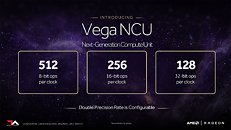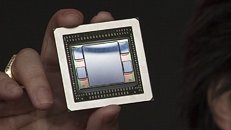Thursday, January 12th 2017

AMD's Vega-based Cards to Reportedly Launch in May 2017 - Leak
According to WCCFTech, AMD's next-generation Vega architecture of graphics cards will see its launch on consumer graphics solutions by May 2017. The website claims AMD will have Vega GPUs available in several SKUs, based on at least two different chips: Vega 10, the high-end part with apparently stupendous performance, and a lower-performance part, Vega 11, which is expected to succeed Polaris 10 in AMD's product-stack, offering slightly higher performance at vastly better performance/Watt. WCCFTech also point out that AMD may also show a dual-chip Vega 10×2 based card at the event, though they say it may only be available at a later date.AMD is expected to begin the "Vega" architecture lineup with the Vega 10, an upper-performance segment part designed to disrupt NVIDIA's high-end lineup, with a performance positioning somewhere between the GP104 and GP102. This chip should carry 4,096 stream processors, with up to 24 TFLOP/s 16-bit (half-precision) floating point performance. It will feature 8-16 GB of HBM2 memory with up to 512 GB/s memory bandwidth. AMD is looking at typical board power (TBP) ratings around 225W.
Next up, is "Vega 20", which is expected to be a die-shrink of Vega 10 to the 7 nm GF9 process being developed by GlobalFoundries. It will supposedly feature the same 4,096 stream processors, but likely at higher clocks, up to 32 GB of HBM2 memory at 1 TB/s, PCI-Express gen 4.0 bus support, and a typical board power of 150W.
AMD plans to roll out the "Navi" architecture some time in 2019, which means the company will use Vega as their graphics architecture for two years. There's even talk of a dual-GPU "Vega" product featuring a pair of Vega 10 ASICs.
Source:
WCCFTech
Next up, is "Vega 20", which is expected to be a die-shrink of Vega 10 to the 7 nm GF9 process being developed by GlobalFoundries. It will supposedly feature the same 4,096 stream processors, but likely at higher clocks, up to 32 GB of HBM2 memory at 1 TB/s, PCI-Express gen 4.0 bus support, and a typical board power of 150W.
AMD plans to roll out the "Navi" architecture some time in 2019, which means the company will use Vega as their graphics architecture for two years. There's even talk of a dual-GPU "Vega" product featuring a pair of Vega 10 ASICs.




187 Comments on AMD's Vega-based Cards to Reportedly Launch in May 2017 - Leak
DOOM is a highly AMD favoring game, meaning that Vega will look better in DOOM than the average game.
It will use a driver derived from the previous drivers, it's not like they are writing one from scratch. There will be continuous tweaks in the coming months, but these benchmarks still represent the "best case" of what we can expect from Vega 10.
If this was a bad demonstration of Vega, they wouldn't have used it you know.
First Ryzen demo: December '16 -> 3.4GHz
Second Ryzen demo: January '16 -> 3.6GHz
So 20% clock increase in 4-5 months.
Precedent shows that getting the 10% - 15% increase in the next few months isn't unreasonable.
Vega 10 is a GP104 competitor.
TitanXp = 471mm
1080 = 314mm (33% smaller than TitanX but 21% slower)
1060 = 200mm (58% smaller than 1080 but 41% slower)
480 = 232mm (15% larger than 1060 but 10% slower)
TitanXm = 601mm
FuryX = 596mm (1% smaller but 5% slower)
Estimates for Vega are between 475mm and 525mm. (www.reddit.com/r/hardware/comments/5m6tfu/vega_die_size_475mm2/)
So at the same die efficiency Vega should be between 20% slower than the TitanX and 10% faster than the TitanX.
However, neither do I think this will 'destroy' Titan XP, and we'll likely have another case of superior in DX12, slower in DX11.
AMD will not make a new driver before the release of Vega. It will be a new release of the same driver, people commonly keep confusing this. The driver implementation for Vega was started a while ago, from now on they will just be doing minor tweaks.
As the product is developed, those new features are added in pieces.
So depending on when a demo occurs, there are different hardware optimizations that may or may not be enabled in the driver being used at that point in time.
Yes, the vega driver development began at the same time as the chip development, but they are both being worked on today as well. Seeing another 10+ % increase before official launch is not out of the question and 10% is the difference from a 1080 and 1080Ti.